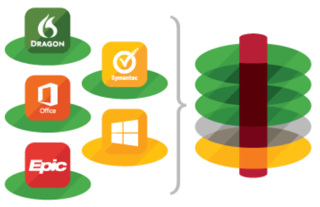Today Citrix announced that they have acquired Unidesk — the leading application packaging (layering) and lifecycle management solution for the digital workspace. If you are not familiar with Unidesk, or application layering technology in general for that matter, I would strongly advice you to go and have a look at their website. They offer a couple of unique features taking application packaging and delivery to a whole new level. As they like to say ‘Layering changes everything‘. Let’s have a look at what this all means for both Citrix and Unidesk.
For starters
I would like to invite you to check out some of the links below in case you have no clue about application layering, how it may benefit you and/or your company or when you would just like to know a bit more about Unidesk, the company itself.
- Unidesk company introduction
- What is application layering, how does it work?
- Unidesk software overview
- Features and benefits
And while on the subject, not too long ago I had a closer look at some of the application layering companies/technologies available today and summarised some of their most important features and differences, have a look here it might be of interest. Of course Unidesk is in there as well.
The announcement
Below I’ll summarize some of the most important highlights that come with the acquisition:
- Citrix bought the company Unidesk, not ‘just’ the technology. This means that all employees/staff, including all engineers etc. will come over to Citrix as well. Definitely a good thing for both companies, they all win.
- Unidesk is/was among the first, if not the first to introduce application layering to the world, needles to say that they have some groundbreaking (and trademarked) features within their portfolio. Combined with Citrix XenApp and XenDesktop will make this a (very) hard package to beat.
- As you might be aware, Citrix introduced App Disks not that long ago, but it never really took off. The same can be said for PvD (Personal vDisk) as well — although it has been around a while longer. Unidesk will replace both technologies in the long run. Though care is taken in slowly deprecating both technologies over time. While I’m not aware of a timeframe at this moment I wouldn’t be surprised if this takes at least another year or so.
- PVS and MCS however, aren’t going anywhere. In fact, Unidesk offers a couple of specific integration features when it comes to PVS for image delivery. I guess we’ll just have to see what they come up with next. Unidesk also offers a unique approach when it comes to single image management, something I could easily see working/integrated with both PVS and MCS as well.
- Layering (in general) makes moving applications to the cloud easier and more flexible (cloud portability), which is also one of the reasons why Citrix in interested in a more advanced/developed layering technology, or company like Unidesk. Be on the lookout for future integrations with the Citrix Cloud.
- All core capabilities of the Unidesk layering portfolio will be made available to all editions of both XenApp and XenDesktop, with just one or two exceptions, at least that I know of know. At no additional costs that is.
- Unidesk’s earlier mentioned cloud portability features and their elastic layering approach (assigning layers at login based on AD memberships) will only be available to XenApp and XenDesktop Platinum customers with an active Software Maintenance contract. Or should I say ‘Select’ as it is called these days, which changes things, since a support contract will no longer be optional, but mandatory. Read more about their new support approach, Citrix Customer Success Services here.
- Unidesk layering technologies work on all major Hypervisors and cloud platforms out there, including the Nutanix Acropolis Hypervisor. Others include: KVM, XenServer, vSphere/ESXi, Hyper-V, Azure and Amazon Web Services. This will not change.
- Even better, Citrix will continue to support all existing and new future Unidesk/Citrix customers! Now that’s sweet right? Using Unidesk on VMware Horizon, call Citrix.
- While the Unidesk portfolio will be tightly integrated with all editions of XenApp and XenDesktop, that’s your licensing covered, there will be separate, stand-alone product licenses available as well, for the abovementioned VMware Horizon customers, for example.
- The goal is to get everything out and available for purchase/download in Q1.
- They are working on, and executing at the same time, a thought through communication plan to all existing customers and partners. The same applies to any customers that might be on the verge of purchasing Unidesk technology. They will be fully updated on the current state of affairs.
- As has been on the road-map of Unidesk for some time now, physical desktops will be supported in the (near) future as well, Citrix will continue to execute any plans that might have been set into motion by Unidesk already.
And there you have it, Unidesk is now part of Citrix, a great move! As soon as any new (non-NDA) information becomes available I will make sure to update this article.
Thanks for reading.










3 responses to “Citrix acquires Unidesk — here’s everything you want/need to know!”
RIP App Disks….hardly got to know you as well as Citrix streaming in XA 5
And probably PvD as well. But you’ll love Unidesk, don’t worry. Citrix Streaming? Did one project with it myself, didn’t like it very much to be honest.
[…] Read the entire article here, Citrix acquires Unidesk — here’s everything you want/need to know! […]